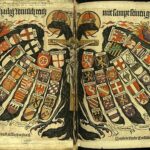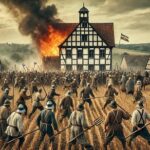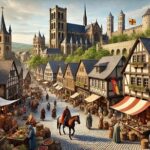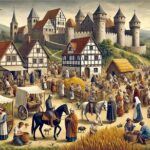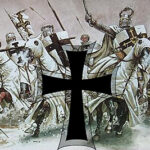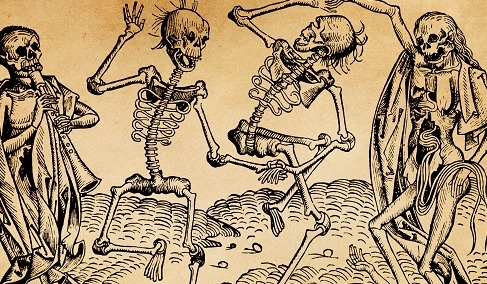
In the mid-14th century, death swept across Europe with horrifying speed. Streets emptied, towns fell silent, and entire communities vanished. This was the Black Death, the deadliest pandemic in European history—and Germany, then a patchwork of feudal territories within the Holy Roman Empire, was hit hard.
The plague didn’t just decimate the population. It triggered profound cultural, economic, and religious shifts that reshaped medieval German life. From the collapse of serfdom in some regions to waves of antisemitic violence, the plague left scars still visible in history books—and sometimes even in the streets of old towns today.
Let’s examine how the Black Death arrived, how it spread, and how it changed Germany forever.
What Was the Black Death?
The Black Death was caused by the bacterium Yersinia pestis, likely transmitted via fleas on rats. It’s now believed that a combination of bubonic, septicemic, and pneumonic forms of the disease swept through Europe.
- Bubonic plague: Caused swollen, painful lymph nodes (buboes).
- Pneumonic plague: Spread through the air, attacking the lungs.
- Septicemic plague: Entered the bloodstream, often killing within hours.
It’s estimated that between 30–50% of Europe’s population died between 1347 and 1352. In German lands, the mortality rate was similar—if not worse in urban centers like Cologne, Nuremberg, and Hamburg.
How the Plague Reached Germany
The plague likely arrived in Germany by 1348, spreading from Italy and France through trade routes and rivers. Merchant caravans, ships, and pilgrim trails carried the disease deep into the empire:
- The Rhine River funneled the plague into key commercial cities.
- Dense trade networks from the Hanseatic League accelerated transmission in the north.
Cities suffered most, but rural areas weren’t spared. With limited medical knowledge and no real treatment, fear and superstition spread almost as fast as the disease.
Immediate Effects
The social and emotional toll was staggering:
- Entire villages were wiped out.
- Mass graves and plague pits appeared everywhere.
- Priests and monks died in droves, trying to administer last rites.
- Panic led to flight from cities, disrupting trade and agriculture.
Contemporary accounts describe a world turned upside down: families abandoning the sick, neighbors hiding indoors, bells tolling endlessly.
Economic Impact
Paradoxically, the plague’s devastation created opportunities:
- With so many dead, labor became scarce. Surviving workers could demand higher wages.
- Serfdom declined in many parts of Germany, especially where lords couldn’t enforce old obligations.
- Land became more available, and peasants gained negotiating power.
- Guilds saw openings for new members as master craftsmen died.
However, in some areas, nobles pushed back—leading to tensions and eventual peasant revolts in the late 14th and 15th centuries.
Religious Responses
The plague tested faith across Germany. Some saw it as divine punishment for sin; others turned to flagellants—groups who wandered from town to town, whipping themselves to atone for collective guilt.
Churches remained central, but their authority wavered:
- Many clergy died, creating a shortage of trained priests.
- Some survivors questioned the Church’s inability to protect them.
- Apocalyptic preaching and millenarian movements grew.
This religious unrest foreshadowed larger spiritual crises—such as the Reformation two centuries later.
Antisemitic Violence
One of the darkest chapters of the Black Death in Germany was the wave of pogroms against Jewish communities.
- Rumors spread that Jews had poisoned wells to cause the plague.
- Hundreds of communities were attacked and destroyed.
- In Strasbourg, for example, over 1,000 Jews were burned alive in 1349—even though the city had no confirmed plague cases at the time.
The emperor, Charles IV, initially tried to stop the violence but eventually caved to local pressures. Many Jews fled to Poland and Eastern Europe, altering the demographic and cultural landscape of Germany.
Cultural and Psychological Shifts
The trauma of the Black Death left psychological scars that seeped into German art and literature:
- Danse Macabre (Dance of Death) images became popular—skeletons leading people of all ranks in a final dance.
- Writers chronicled suffering with raw intensity. Chronicles and sermons from the period capture deep existential anxiety.
- A new fascination with mortality, judgment, and salvation emerged.
This preoccupation with death influenced everything from altar art to mystical writing, and even medical theory, which slowly began to shift away from superstition.
Urban Changes and Public Health
In response to the plague, German cities began experimenting with early public health measures:
- Quarantines and isolation for the sick
- Regulation of burials and corpse disposal
- Efforts to clean streets and control rats (though germ theory was still centuries away)
These efforts were primitive but marked the beginning of civic responses to health crises in German towns.
Long-Term Legacy
The Black Death was not a one-time event. Recurrences continued well into the 17th century. But the first wave left a permanent mark:
- Feudal bonds were loosened, altering power dynamics.
- Social mobility increased—for some.
- Urban development shifted, with new neighborhoods and cemeteries.
- Trust in institutions—from local lords to the Church—was shaken.
Germany’s political fragmentation made coordinated responses difficult, but it also allowed for localized innovation in governance, health, and labor policy.
The Black Death devastated medieval Germany, but it also transformed it. In the wake of suffering came economic change, social upheaval, and cultural adaptation. The pandemic tested the fabric of medieval society—and in many places, rewove it entirely.
To explore more about life in this era, visit Medieval German Feudal Society, The Rise of the Hanseatic League, or explore the spiritual shifts that followed in The Reformation and Religious Conflicts.
The Middle Ages in German History – An overview of the political, cultural, and religious transformations that shaped Germany from the fall of the Carolingian Empire to the dawn of the Reformation, including the rise of the Holy Roman Empire and medieval society.
Otto I and the Birth of the Holy Roman Empire – Explore how Otto I’s coronation in 962 marked the formal beginning of the Holy Roman Empire, establishing a powerful political and religious legacy in medieval Germany.
Medieval German Feudal Society – Learn how landholding, loyalty, and class defined the social structure of medieval Germany, shaping both everyday life and royal authority.
The Hanseatic League – Discover the rise of this powerful trade alliance of northern German cities that dominated commerce across the Baltic and North Seas during the late Middle Ages.
German Castles and Knightly Culture – Dive into the architectural and chivalric world of medieval Germany, where fortified castles and knightly ideals shaped warfare, literature, and noble identity.
Peasant Revolts in the Middle Ages – Examine the causes and consequences of peasant uprisings in medieval Germany, including their role in challenging feudal oppression and economic hardship.
The Teutonic Knights and Eastern Expansion – Follow the military and missionary campaigns of the Teutonic Order as they expanded Germanic influence eastward into pagan territories.
German Medieval Universities – Explore the intellectual revival of the High Middle Ages, as cathedral schools and universities flourished in German cities, preserving classical knowledge and fostering new ideas.
The Golden Bull of 1356 – Understand the constitutional landmark that formalized the election of German kings, shaping imperial governance in the Holy Roman Empire for centuries.
